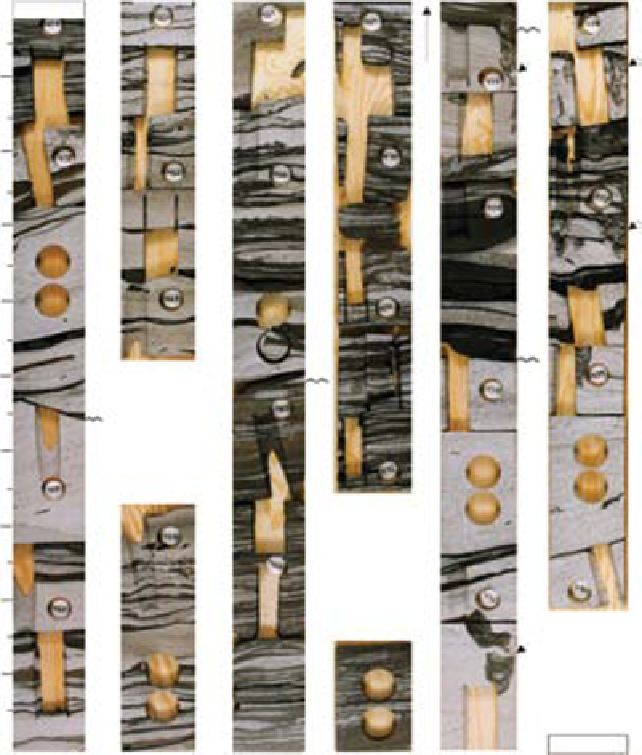Geoscience Reference
In-Depth Information
100
Top
90
80
FM
70
FM
60
FM
50
40
30
20
10
0 cm
Base
Fig. 17.
Facies association FA9. Heterolithic tidal (point) bars displaying upward-thinning of the interbedded sandstone
and mudstone layers with local sharp-based, stacked, upward-sandier intervals. Notice the presence of large vertical
Diplocraterion
burrows (black arrow). Example taken from reservoir zone Tilje 3.2 (T3.2).
mixed sandstone-mudstone wavy-bedded hetero-
lithics (F5.2.1). These deposits are transitionally
overlain by medium to fine-grained sandstone-
dominated heterolithics (F5.1) showing basal
cross-bedded sandstones (with rip-up mud
clasts) that alternate with inclined and coupled
fluid-mud layers. Vertically in the succession,
the thicknesses of mudstone-layers decrease to
thin laminae. The sedimentary structures within
the sandstone layers suggest unidirectional cur-
rents. However, reverse palaeocurrent indicators
and double mud drapes indicate a tidal influence.
The lower stratigraphic intervals show abundant
thick homogeneous mudstone layers interpreted
to result from high suspended-sediment concen-
trations (fluid muds), indicating a channel-
bottom depositional setting (Ichaso & Dalrymple,
2009). The inclined mudstones (~5°) interbedded
with sandstone layers are interpreted as accre-
tion surfaces of inclined heterolithic deposits
(IHS), commonly developed near the top of point
bars (Thomas
et al
., 1987; Makaske & Weerts,
2005). Sandstone layers containing rip-up mud
clasts are interpreted to represent minor erosional
events. The upward thinning of the sandy layers
and decrease of mudstone-layer thickness and
abundance suggest vertical decrease in the sus-
pended-sediment concentration in the water
column. FA9 is interpreted to be deposited on
within-channel elongate tidal bars or bank-
margin tidal point bars. The low-diversity ichno-
logical assemblage and the reduced level of
bioturbation suggest stressed conditions proba-
bly due to high rates of sedimentation along
the channel margins, together with low salinity
levels.

Search WWH ::

Custom Search